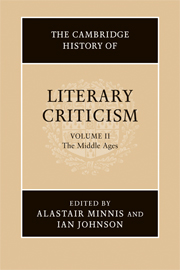Book contents
- Frontmatter
- Introduction
- I THE LIBERAL ARTS AND THE ARTS OF LATIN TEXTUALITY
- II THE STUDY OF CLASSICAL AUTHORS
- III TEXTUAL PSYCHOLOGIES: IMAGINATION, MEMORY, PLEASURE
- IV VERNACULAR CRITICAL TRADITIONS: THE EARLY MIDDLE AGES
- V VERNACULAR CRITICAL TRADITIONS: THE LATE MIDDLE AGES
- 14 Latin commentary tradition and vernacular literature
- 15 Vernacular literary consciousness c. 1100–c. 1500: French, German and English evidence
- 16 Occitan grammars and the art of troubadour poetry
- 17 Literary theory and polemic in Castile, c. 1200–c. 1500
- 18 Literary criticism in Middle High German literature
- 19 Later literary criticism in Wales
- VI LATIN AND VERNACULAR IN ITALIAN LITERARY THEORY
- VII BYZANTINE LITERARY THEORY AND CRITICISM
- Bibliography
- Index
- References
19 - Later literary criticism in Wales
from V - VERNACULAR CRITICAL TRADITIONS: THE LATE MIDDLE AGES
Published online by Cambridge University Press: 28 March 2008
- Frontmatter
- Introduction
- I THE LIBERAL ARTS AND THE ARTS OF LATIN TEXTUALITY
- II THE STUDY OF CLASSICAL AUTHORS
- III TEXTUAL PSYCHOLOGIES: IMAGINATION, MEMORY, PLEASURE
- IV VERNACULAR CRITICAL TRADITIONS: THE EARLY MIDDLE AGES
- V VERNACULAR CRITICAL TRADITIONS: THE LATE MIDDLE AGES
- 14 Latin commentary tradition and vernacular literature
- 15 Vernacular literary consciousness c. 1100–c. 1500: French, German and English evidence
- 16 Occitan grammars and the art of troubadour poetry
- 17 Literary theory and polemic in Castile, c. 1200–c. 1500
- 18 Literary criticism in Middle High German literature
- 19 Later literary criticism in Wales
- VI LATIN AND VERNACULAR IN ITALIAN LITERARY THEORY
- VII BYZANTINE LITERARY THEORY AND CRITICISM
- Bibliography
- Index
- References
Summary
Though late-medieval Wales produced no Ars poetica it did produce texts which enunciated principles and standards relevant to literary composition and which highlighted matters at issue in contemporary literary life. Foremost among these were the various recensions of the bardic grammar (gramadegau'r penceirddiaid) and the contentions (ymrysonau) involving some of the leading poets of the age.
The bardic grammar
Copies of the bardic grammar survive in four medieval manuscripts: Aberystwyth, National Library of Wales, MS Peniarth 20 (c. 1330); Oxford, Bodleian Library, MS Jesus College 111 [the Red Book of Hergest] (c. 1400); Aberystwyth, National Library of Wales, MS Llanstephan 3 (c. 1425), and Bangor, University of Wales, MS Bangor 1 (c. 1450). The relationship between the texts is complicated: the manuscript copies represent different recensions with considerable variation in wording, order and substance, the Red Book, Llanstephan 3 and Bangor 1 texts displaying an affinity which is not shared with the Peniarth 20 version. Paradoxically, in view of its date, it is the Red Book text which preserves the earliest recension of the grammar; notwithstanding its status as the earliest manuscript text the Peniarth 20 grammar represents a later, more developed recension. Peniarth 20, however, provides a terminus ante quem for the composition of the grammar, and this, together with internal evidence – a metrical example dated to 1316–17 – makes it likely that it was composed during the second decade of the fourteenth century.
- Type
- Chapter
- Information
- The Cambridge History of Literary Criticism , pp. 549 - 558Publisher: Cambridge University PressPrint publication year: 2005



